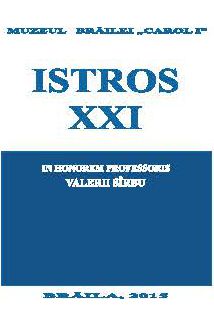Primele menționări cartografice ale fortificației de epoca bronzului de la Cornești-Iarcuri, jud. Timiș
First Map-Drawing Mentions of the Bronze Age Fortification from Corneşti-Iarcuri, Timiş County
Author(s): Alexandru SzentmiklosiSubject(s): History
Published by: Editura Istros - Muzeul Brailei
Keywords: Banat; Cornesti; fortification; Bronze Age; Cruceni-Belegiš culture; maps; 18th century.
Summary/Abstract: Iarcurile, the largest fortification of the Bronze Age from Europe, is situated at about 18 km north to Timișoara, and north to the locality Cornești. The toponym of „Iarcuri” can be associated either to the traces of several bounding trenches or earthen fortifications (ramparts with defensive ditches), or to the sections of the ancient Roman roads. The term of „iarc” („bounding trench”) could derive either from the Turkish word „ark”/”arka” or from the Slave „jarak”, but the general meaning is that of „ditch”, „channel”, „trench”. The huge prehistoric fortification came into notice of the military surveyors at the beginning of the 18th century. The earliest representation of the fortification from Cornești-Iarcuri known nowadays appeared on a map drawn up in 1720 (Mappa von dem Temesvaer District). The following representations of the fortification from Cornești appeared on several copies of the maps drafted by the engineer D. Haring, by the lieutenant C.I. Kayser and by the ensigner D’Hautemont (so called „maps Mercy”), drafted during the period between 1723-1725. The ramparts that delimited the Enclosures I, II and, partially, Enclosure III of the prehistoric fortification had been marked by the Habsburg surveyors with the toponym „Schantz Klenovaz/Schanz Kienovatz”. This toponym would be used on different maps from the 18th century. Among the latest maps are those published in Wien in 1765 and 1800. Initially assigned to the Avar populations, the ramparts from Cornești-Iarcuri are dated in the Late Bronze Age (the second half of the 2nd millennium B.C), and they were constructed by the communities of Cruceni-Belegiš culture from the region.
Journal: ISTROS
- Issue Year: 21/2015
- Issue No: 1
- Page Range: 31-55
- Page Count: 25
- Language: English, Romanian
- Content File-PDF

